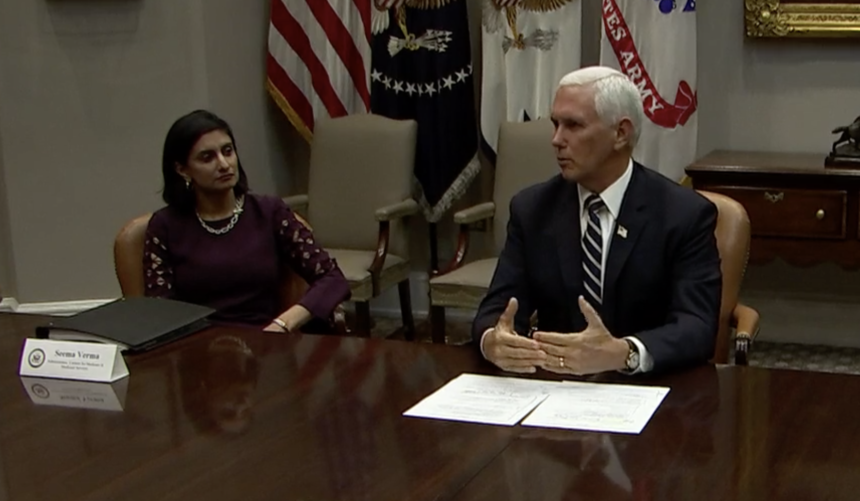
The Centers for Medicare & Medicaid Services has issued new guidance for visitation in nursing homes during the COVID-19 pandemic.
The guidance lays out a framework for nursing homes to facilitate in-home visitation, Vice President Mike Pence said during a roundtable discussion Thursday.
A memo sent today to state survey directors makes clear that visitations can be made for more than pure end-of-life reasons, and include physical touching in certain instances. In addition, communal dining and activities may take place as long as six-foot distancing and other precautions are observed.
“Outdoor visits are encouraged. Indoor visitation is allowed if there’s no new cases in the previous two weeks and if certain core principals — like screening, resident and staff testing, hygiene, social distancing and cleansing — are put into effect,” Pence said at the discussion attended by numerous members of the Coronavirus Commission on Safety and Quality in Nursing Homes. In attendance were key nursing home association members and officials.
“Nursing home facilities will continue to use that COVID-19 county positivity rate to determine the degree to which indoor visitation can take place,” he added.
Per the memo, the “Core Principles of COVID-19 Infection Prevention” are:
- Screening of all who enter the facility for signs and symptoms of COVID-19 (e.g., temperature checks, questions or observations about signs or symptoms), and denial of entry of those with signs or symptoms
- Hand hygiene (use of alcohol-based hand rub is preferred)
- Face covering or mask (covering mouth and nose)
- Social distancing at least six feet between persons
- Instructional signage throughout the facility and proper visitor education on COVID19 signs and symptoms, infection control precautions, other applicable facility practices (e.g., use of face covering or mask, specified entries, exits and routes to designated areas, hand hygiene)
- Cleaning and disinfecting high frequency touched surfaces in the facility often, and designated visitation areas after each visit
- Appropriate staff use of Personal Protective Equipment (PPE)
- Effective cohorting of residents (e.g., separate areas dedicated COVID-19 care)
- Resident and staff testing conducted as required.
Among other things, CMS has paved the way for Civil Monetary Penalty funds to make greater access to outdoor and indoor visits possible.
“CMS will now approve the use of CMP funds to purchase tents for outdoor visitation and/or clear dividers (e.g., Plexiglas or similar products) to create physical barriers to reduce the risk of transmission during in-person visits,” the memo to states reads.
“Compassionate care situations” that would permit close, in-person visits involve more than just “end-of-life” scenarios, the memo to the states.
According to CMS, examples of other types of compassionate care situations include, but are not limited to:
• A resident, who was living with their family before recently being admitted to a nursing
home, is struggling with the change in environment and lack of physical family support.
• A resident who is grieving after a friend or family member recently passed away.
• A resident who needs cueing and encouragement with eating or drinking, previously
provided by family and/or caregiver(s), is experiencing weight loss or dehydration.
• A resident, who used to talk and interact with others, is experiencing emotional distress,
seldom speaking, or crying more frequently (when the resident had rarely cried in the
past).
“Allowing a visit in these situations would be consistent with the intent of, ‘compassionate care situations.’ Also, in addition to family members, compassionate care visits can be conducted by any individual that can meet the resident’s needs, such as clergy or lay persons offering religious and spiritual support,” CMS said.
In addition, during a compassionate care visit, personal contact may take place, but “it should only be done following all appropriate infection prevention guidelines, and for a limited
amount of time. Through a person-centered approach, facilities should work with residents,
families, caregivers, resident representatives, and the Ombudsman program to identify the need for compassionate care visits.”
Facilities that have not had any positive COVID-19 cases in the last 14 days and are in a county with a low or medium positivity rate may not restrict visitations “without a reasonable clinical or safety cause” consistent with regulations, CMS noted. Doing so could subject a provider to the threat of citation and penalties.
CMS previously approved the use of CMP funds to buy communication aides such as webcams or tablet computers to enable virtual visits with loved ones. Facilities are limited to one such device per seven to 10 devices, and a limit of $3,000 per facility, to ensure balanced distribution of funds, officials said.
Now facilities also may apply to use CMP funds to enable in-person visits, the memo to surveyors explained. Funding for tents and clear dividers also will be limited to a maximum of $3,000 per facility.
The guidance comes after the release of an expansive report by the Coronavirus Commission on Safety and Quality in Nursing Homes on Wednesday. The report recommended that CMS update visitation guidance, recognizing that visitation is a vital right for residents.
This is a developing story. Please check back for updates.





